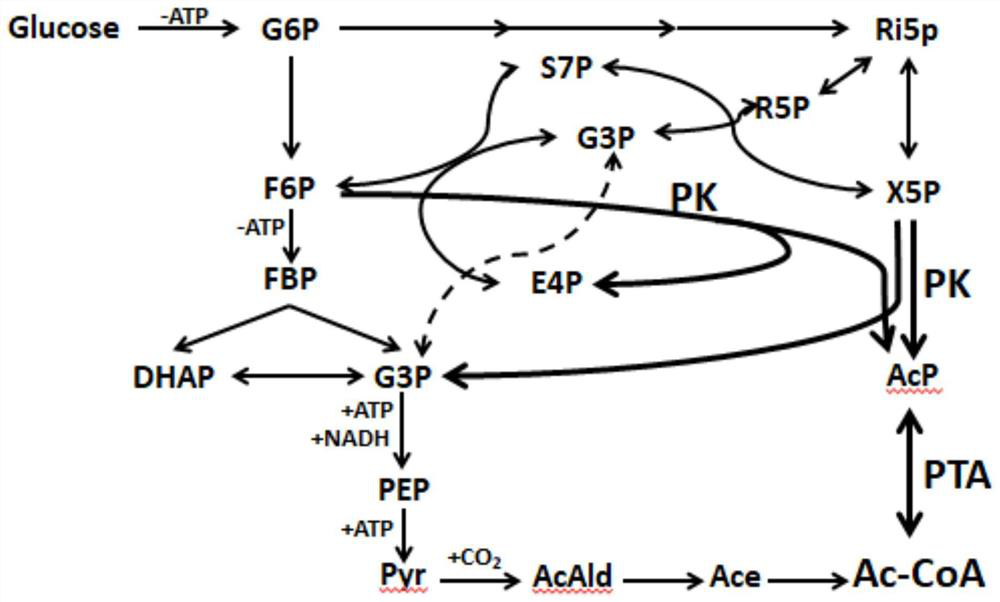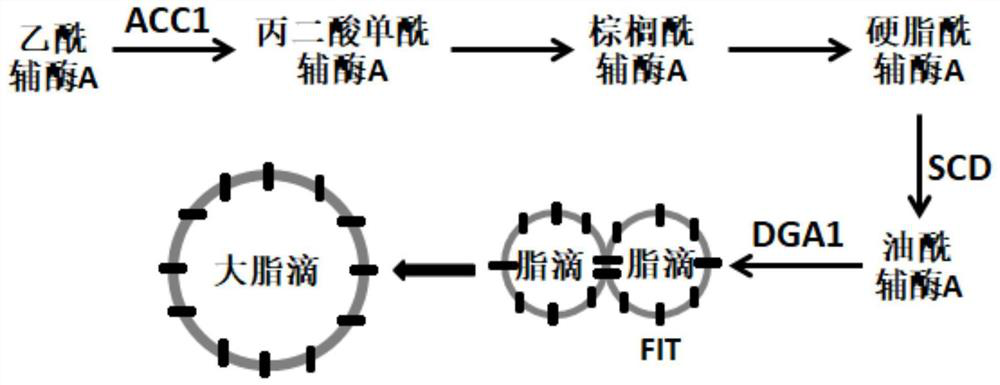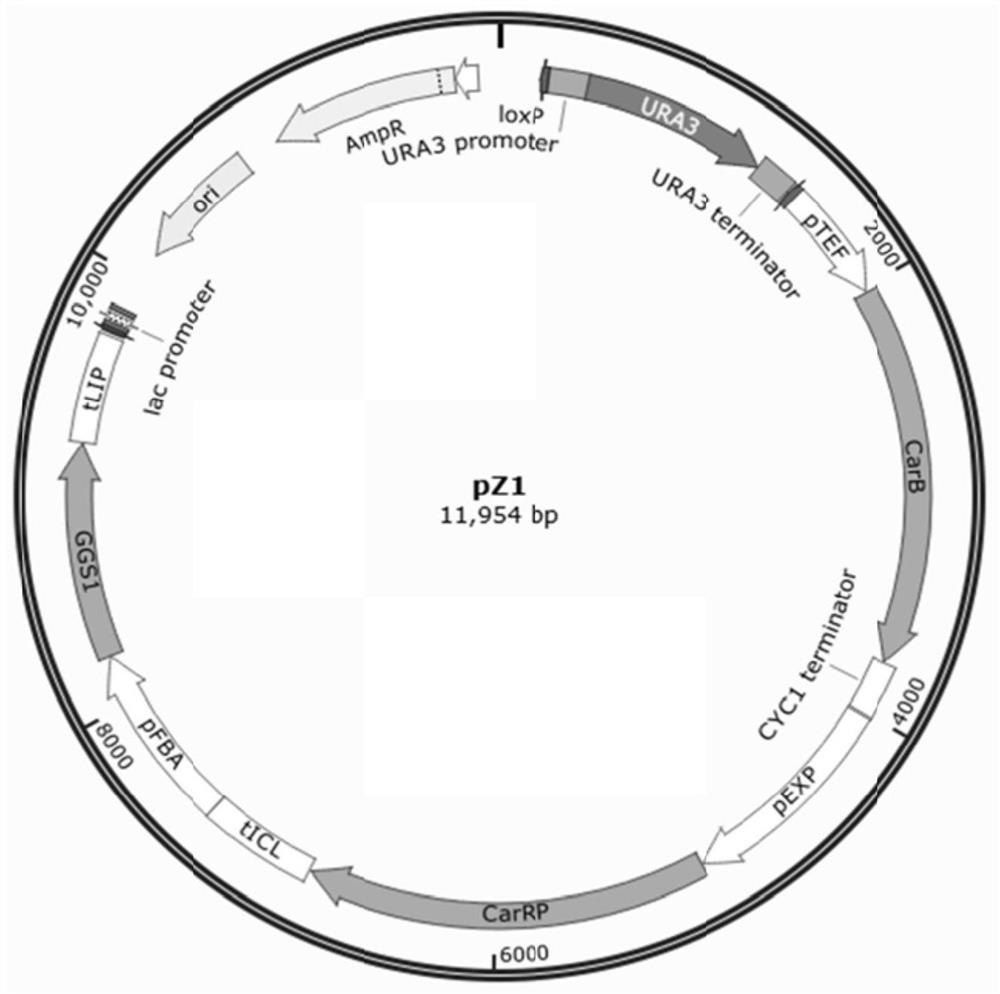Genetically engineered bacterium for improving yield of beta-carotene and application thereof
A carotene and gene technology, applied in the direction of enzymes, fungi, acyltransferases, etc., can solve the problems of not being able to further break through the yield, not considering the use of carbon sources, and reducing power supply for the storage of final products, so as to increase the content of lipid droplets and Volume, reduce carbon loss, increase storage effect
- Summary
- Abstract
- Description
- Claims
- Application Information
AI Technical Summary
Problems solved by technology
Method used
Image
Examples
Embodiment 1
[0111] Embodiment 1 gene selection and vector construction
[0112] Acetyl-CoA is an important precursor for the synthesis of fatty acids, organic acids and terpenes by microorganisms, but the natural synthesis of acetyl-CoA in most microbial strains results in the loss of carbon. The phosphoketolase pathway (eg figure 1 Shown) phosphoketolase (PK) and phosphate acetyltransferase (PTA) can catalyze 6-phosphate fructose (F6P) or 5-phosphate xylulose (X5P) to generate acetyl-CoA, the process does not generate carbon dioxide, no carbon It also produces ATP and NADPH to provide energy and reducing power for cellular anabolism.
[0113] Lipid droplets (LD) are organelles widely present in cells, which are surrounded by neutral lipids with a single layer of phospholipid membrane. Lipid droplets generate malonyl-CoA under the catalysis of ACC1 through acetyl-CoA, which generates palmitoyl-CoA and stearoyl-CoA under the action of FAS, and these two saturated fatty acids generate ole...
Embodiment 2
[0161] Example 2 Construction of high-yield β-carotene integrated strain
[0162] Recombinant engineering bacteria randomly integrate plasmid pZ1, plasmid pZ2, plasmid pZ3, plasmid pZ4, plasmid pZ5, and plasmid pZ6 into the genome of Yarrowia lipolytica through non-homologous recombination; including the following steps:
[0163] (1) The constructed recombinant plasmid pZ1 was linearized by excising the original pUC19 backbone with NotⅠ, and then introduced into Yarrowia lipolytica strain Polf, which is deficient in uracil synthesis, and the strain with the highest β-carotene production was detected to complete the first round of strain recombination iterate.
[0164] (2) Excision of the URA3 gene by introducing a circular plasmid expressing Cre enzyme Y-Cre to restore the selection marker to the first-generation engineering strain producing β-carotene, and then re-introducing the linearized pZ2 plasmid and screening for high-yield β-carotene to complete the second stage Two ...
Embodiment 3
[0174] Embodiment 3 industrial fermentation test
[0175] After the genetically engineered bacteria ZTQ211, ZTQ30 and ZTQ5320 constructed in Example 2 were subjected to high-density fermentation in a 3L fermenter, the unit yield of β-carotene was detected.
[0176] The fermentation method comprises the following steps:
[0177] S1. Cultivation of primary seed liquid: inoculate a single colony of the recombinant strain F5 on a solid YPD plate into a 100ml Erlenmeyer flask containing 20ml of YPD liquid medium, and cultivate for 48 hours at 30°C with a shaker speed of 200rpm.
[0178] S2. the primary seed solution obtained in step S1 is transferred to the 300ml Erlenmeyer flask containing 100ml YPD liquid medium by 1% (wt) inoculum, 30 ℃, shaker speed 200rpm, cultivate 10 hours cell OD600 reaches 10 , to obtain the secondary seed solution.
[0179] S3. The secondary seed liquid obtained in step S2 is transferred to the 3L fermenter containing 1L fermentation medium by 10% (wt) ...
PUM
 Login to View More
Login to View More Abstract
Description
Claims
Application Information
 Login to View More
Login to View More - R&D
- Intellectual Property
- Life Sciences
- Materials
- Tech Scout
- Unparalleled Data Quality
- Higher Quality Content
- 60% Fewer Hallucinations
Browse by: Latest US Patents, China's latest patents, Technical Efficacy Thesaurus, Application Domain, Technology Topic, Popular Technical Reports.
© 2025 PatSnap. All rights reserved.Legal|Privacy policy|Modern Slavery Act Transparency Statement|Sitemap|About US| Contact US: help@patsnap.com



